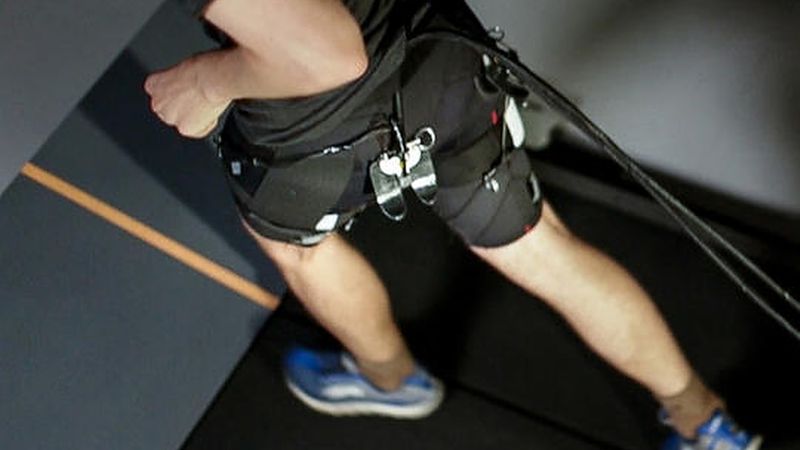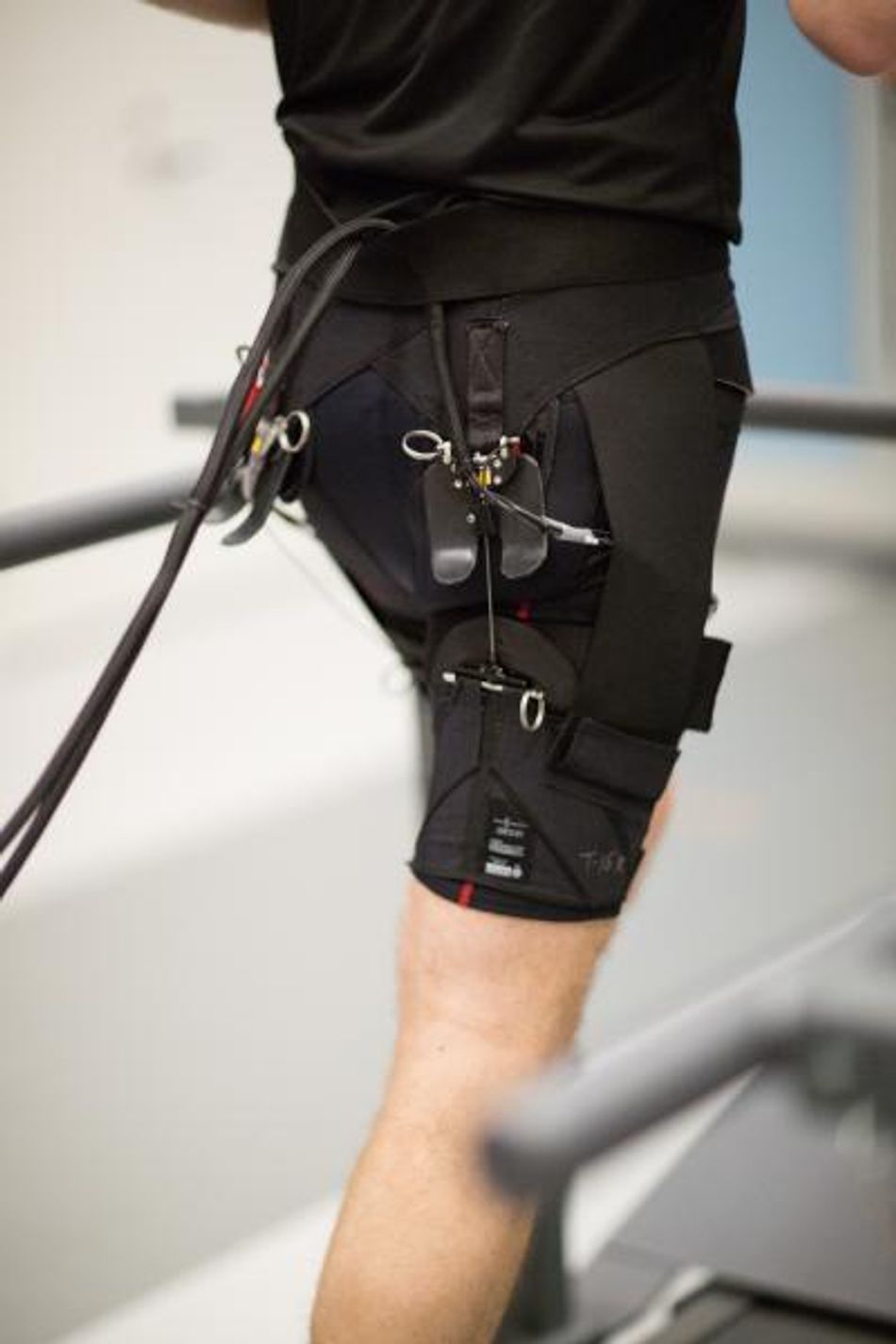Tethered soft exosuit reduces the metabolic cost of running
New robotic exosuit could push the limits of human performance and lead to new wearable technologies for athletes and consumers

Researchers have demonstrated a tethered soft exosuit that can reduce the metabolic cost of running on a treadmill by 5.4 percent compared to not wearing the exosuit (Image courtesy of The Wyss Institute)
What if running the 26.2 miles of a marathon only felt like running 24.9 miles, or if you could improve your average running pace from 9:14 minutes/mile to 8:49 minutes/mile without weeks of training? Researchers at the Harvard John A. Paulson School of Engineering and Applied Sciences (SEAS) and the Wyss Institute for Biologically Inspired Engineering at Harvard University have demonstrated that a tethered soft exosuit can reduce the metabolic cost of running on a treadmill by 5.4 percent compared to not wearing the exosuit, bringing those dreams of high performance closer to reality.
"Homo sapiens has evolved to become very good at distance running, but our results show that further improvements to this already extremely efficient system are possible,” said author Philippe Malcolm, former postdoctoral research fellow at SEAS and the Wyss Institute, and now Assistant Professor at the University of Nebraska, Omaha, where he continues to collaborate on this work.
The study appears today in Science Robotics.
Running is a naturally more costly form of movement than walking, so any attempt to reduce its strain on the body must impose a minimal additional burden. The soft exosuit technology developed in the lab of Conor Walsh, John L. Loeb Associate Professor of Engineering and Applied Sciences at SEAS and Wyss Core Faculty member, represents an ideal platform for assisted running, as its textile-based design is lightweight and moves with the body.
A team of scientists in Walsh’s lab led by postdoctoral fellow Giuk Lee performed the study with an exosuit that incorporated flexible wires connecting apparel anchored to the back of the thigh and waist belt to an external actuation unit. As subjects ran on a treadmill wearing the exosuit, the actuation unit pulled on the wires, which acted as a second pair of hip extensor muscles applying force to the legs with each stride. The metabolic cost was measured by analyzing the subjects’ oxygen consumption and carbon dioxide production while running.
The team tested two different “assistance profiles,” or patterns of wire-pulling. One was based on human biology that applied force starting at the point of maximum hip extension observed in normal running. The other was based on a simulation of exoskeleton-assisted running from a group at Stanford University, which applied force slightly later in the running stride. The Stanford study suggested that the optimal point to provide assistive force might not be the same as the biological norm. Confirming this suspicion, Lee and colleagues found that the simulation-based profile outperformed the biology-based profile in reducing metabolic cost by about a factor of two.
As the authors note in the paper, “Our finding supports a paradigm shift toward the concept that mimicking our current understanding of biology is not necessarily always optimal.”
To clarify why applying force later in running stride improved metabolic expenditure so dramatically, the team analyzed what was happening to the subjects’ other joints when their hip joints were being assisted by the actuating wires. They found that the simulation-based profile also affected knee extension and the forces between the foot and the ground, while the biology-based profile did not.
“The biological profile only takes into account the amount of torque in the hip joint, but the human body is not a series of independently acting parts - it’s full of muscles that act on multiple joints to coordinate movement,” said Lee. “Applying force to the hip affects the whole body system, and we need to consider that in order to give the best assistance.”
While the study’s results suggest that the increased biomechanical involvement of the simulation-based assistance profile is responsible for the reduction in metabolic cost, further biomechanical analyses are needed to confirm its findings.
The team hopes to continue this research to reduce the metabolic cost of running even more.
“We only tested two actuation profiles in this study, so it will be interesting to see how much more the cost of running can be reduced with further optimization of the system,” said Malcolm.
“Our goal is to develop a portable system with a high power-to-weight ratio so that the benefit of using the suit greatly offsets the cost of wearing it. We believe this technology could augment the performance of recreational athletes and/or help with recovery after injury,” said Lee.
The days of a battery-powered exosuit for high-performance runners are still beyond the horizon, as the actuator unit (including motors, electronics, and power supply) in this study was off-board, but the authors say technology is moving toward making an untethered assistive exosuit possible in the near future.
“This study is a great example of how our team can quickly leverage its experience and expertise in wearable technology and biomechanics to demonstrate how human performance can be improved in new application areas,” said Walsh.
